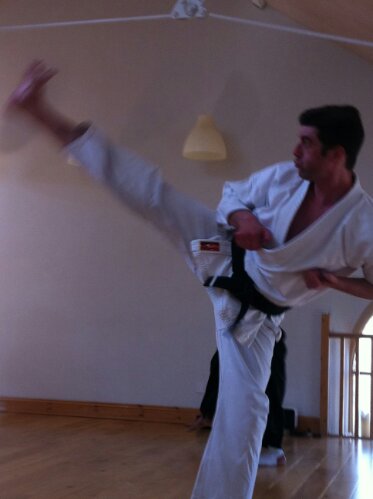Our other ‘great’ John San has written this article for the dojo, a wonderful perspective from a martial artist way into his sixties, and a great inspiration to those younger than him about the gift this amazing subject gives to us all! Richard Sen
I took up karate rather late in life – at the age of 58 in fact. At first, I simply wanted to learn some self-defence as I was frequently required to collect my two daughters from the centre of Cheltenham on a Saturday night when the bars and clubs were closing. Sitting in my car at two o’clock in the morning, I often witnessed fights and, on one occasion, I even had to eject forcibly a couple of inebriated youths from my car who thought that it was a taxi. Fortunately, I never had any major problems, but I was always aware that something serious could happen and I wanted to be ready just in case it did. Up until that time, my life-style had been more or less sedentary. I had always worked in an academic environment; with no interest whatsoever in sports or physical exercise, except perhaps for the odd keep-fit class. Consequently, I had to summon up a lot of courage merely to enquire about self-defence classes.
And that is how it all came about. In late 200I, I contacted Richard-san – my future sensei – to arrange a lesson in what was then termed ‘modern combat’. I vividly remember the first thing that he asked me to do at this session. “Punch this pad!” he said. So I clenched my fist and punched it. “No,” he exclaimed, “I said “Punch it!” I thought that I had and wondered what was wrong with it. Now, after ten years or so of karate – and a black belt – I know precisely what was wrong with it!
I gained my BAMA black belt in 2009 when I was 64 – something that I would never have thought possible when I started out.  Now at the age of 68, I look back over the last decade and see clearly what karate has given me – confidence, motivation, fitness and speed of action. All this has arisen through a greater understanding of the power of ‘kime’ and ’zanshin’, achieved as a result of the private training, encouragement and guidance provided by Richard-san.
Now at the age of 68, I look back over the last decade and see clearly what karate has given me – confidence, motivation, fitness and speed of action. All this has arisen through a greater understanding of the power of ‘kime’ and ’zanshin’, achieved as a result of the private training, encouragement and guidance provided by Richard-san.
While – despite my ‘advanced’ year – I enjoy most of all the combat sessions with Richard-san and any other grades that turn up on a Saturday afternoon! I have also come to appreciate that ‘kata’ and combat are in fact one.
The road towards a black belt has been hard, but it has been worth all the effort (and bruises) along the way. I am only sorry that my long-term training partner, Roy-san, was unable to accompany me on this journey due to a continued injury – that absolutely had nothing to do with me! 🙂
And now that I have achieved this level and honed my combat skills, my daughters are married and no longer go clubbing – well, at least not in Cheltenham – but I should certainly be happy in the future to provide a taxi service for my grandchildren. No, better still, I’ll start teaching them how to defend themselves before then because by the time that they are old enough to go to bars and clubs on a Saturday night, I shall be in my eighties – but hopefully still ‘combat ready’ !
Sensei John




















